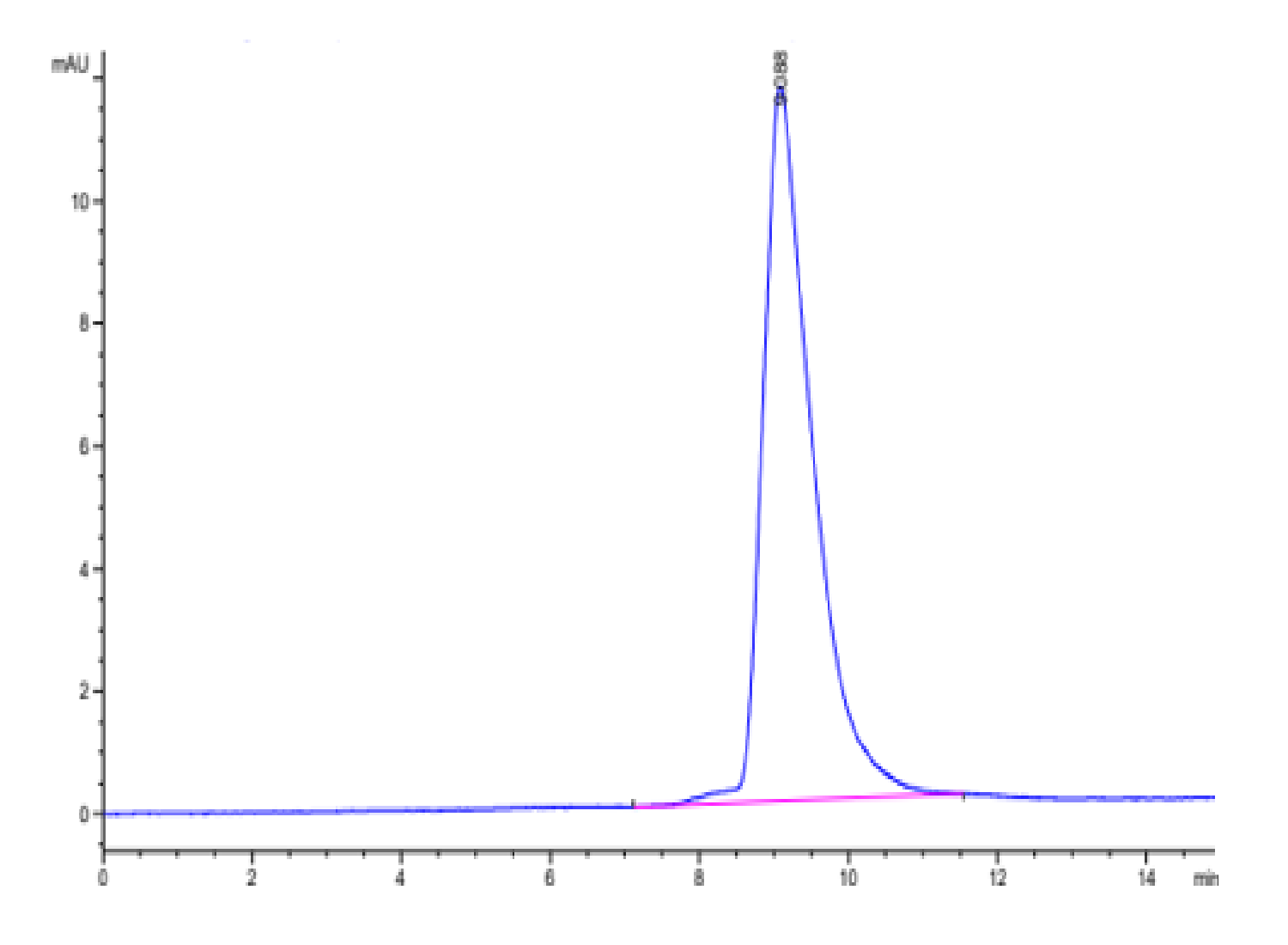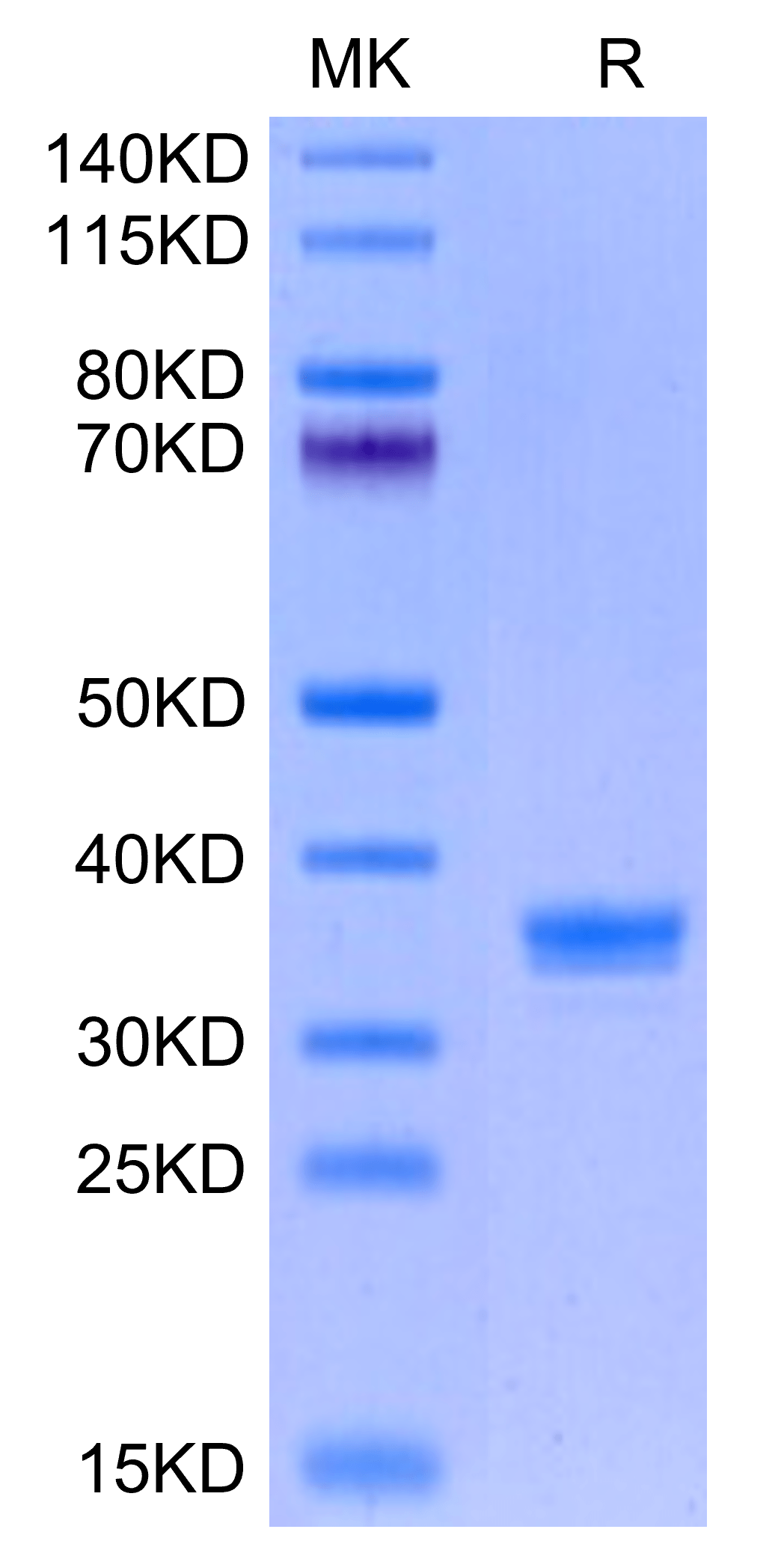| Weight | 1 lbs |
|---|---|
| Dimensions | 9 × 5 × 2 in |
| accession | NP_598499 |
| express system | HEK293 |
| product tag | C-His |
| purity | > 95% as determined by Tris-Bis PAGE;> 95% as determined by HPLC |
| background | The Capillary Morphogenesis Gene 2 (CMG2) gene encodes an Anthrax toxin receptor (ANTXR2), ANTXR2/CMG2 was originally identified as a result of up-regulation during capillary morphogenesis of endothelial cells (ECs) cultured in vitro. ANTXR2/CMG2 functions to promote endothelial proliferation and morphogenesis during sprouting angiogenesis, consistent with the endothelial expression of ANTXR2/CMG2 in several vascular beds. |
| molecular weight | The protein has a predicted MW of 32.00 kDa. Due to glycosylation, the protein migrates to 33-38 kDa based on Tris-Bis PAGE result. |
| available size | 100 µg, 500 µg |
| endotoxin | Less than 1EU per μg by the LAL method. |
Mouse ANTXR2 Protein 3204
$270.00 – $900.00
Summary
- Expression: HEK293
- Pure: Yes (HPLC)
- Amino Acid Range: Gln32-Gly318
Mouse ANTXR2 Protein 3204
| protein |
|---|
| Size and concentration 100, 500µg and lyophilized |
| Form Lyophilized |
| Storage Instructions Valid for 12 months from date of receipt when stored at -80°C. Recommend to aliquot the protein into smaller quantities for optimal storage. Please minimize freeze-thaw cycles. |
| Storage buffer Shipped at ambient temperature. |
| Purity > 95% as determined by Tris-Bis PAGE |
| target relevance |
|---|
| The Capillary Morphogenesis Gene 2 (CMG2) gene encodes an Anthrax toxin receptor (ANTXR2),ANTXR2/CMG2 was originally identified as a result of up-regulation during capillary morphogenesis of endothelial cells (ECs) cultured in vitro. ANTXR2/CMG2 functions to promote endothelial proliferation and morphogenesis during sprouting angiogenesis, consistent with the endothelial expression of ANTXR2/CMG2 in several vascular beds. |
| Protein names Anthrax toxin receptor 2 (Capillary morphogenesis gene 2 protein) (CMG-2) |
| Protein family ATR family |
| Mass 53666Da |
| Function Necessary for cellular interactions with laminin and the extracellular matrix. {ECO:0000269|PubMed:11683410, ECO:0000269|PubMed:12973667}.; (Microbial infection) Receptor for the protective antigen (PA) of B.anthracis (PubMed:12700348, PubMed:15243628, PubMed:15326297). Binding of PA leads to heptamerization of the receptor-PA complex (PubMed:12700348, PubMed:15243628, PubMed:15326297). Upon binding of the PA of B.anthracis, the complex moves to glycosphingolipid-rich lipid rafts, where it is internalized via a clathrin-dependent pathway (PubMed:12551953, PubMed:15337774). In the endosomal membrane, at pH under 7, the complex then rearranges and forms a pore allowing the other components of anthrax toxin to escape to the cytoplasm (PubMed:12551953, PubMed:15337774). {ECO:0000269|PubMed:12551953, ECO:0000269|PubMed:12700348, ECO:0000269|PubMed:15243628, ECO:0000269|PubMed:15326297, ECO:0000269|PubMed:15337774}. |
| Subellular location [Isoform 1]: Cell membrane {ECO:0000269|PubMed:12700348}; Single-pass type I membrane protein {ECO:0000255}. Note=Expressed at the cell surface. {ECO:0000269|PubMed:12700348}.; [Isoform 2]: Endoplasmic reticulum membrane {ECO:0000269|PubMed:11683410}; Single-pass type I membrane protein {ECO:0000255}. Note=Expressed predominantly within the endoplasmic reticulum and not at the plasma membrane. {ECO:0000269|PubMed:11683410}.; [Isoform 3]: Secreted {ECO:0000305}. |
| Tissues Expressed in prostate, thymus, ovary, testis, pancreas, colon, heart, kidney, lung, liver, peripheral blood leukocytes, placenta, skeletal muscle, small intestine and spleen. {ECO:0000269|PubMed:14508707}. |
| Structure Binds laminin, and possibly also collagen type IV. {ECO:0000269|PubMed:11683410}.; (Microbial infection) Interacts (via VWFA domain) with the protective antigen (PA) of B.anthracis. {ECO:0000269|PubMed:12551953, ECO:0000269|PubMed:12700348, ECO:0000269|PubMed:15243628, ECO:0000269|PubMed:15326297, ECO:0000269|PubMed:15337774}. |
| Target Relevance information above includes information from UniProt accession: P58335 |
| The UniProt Consortium |
Data
 |
| The purity of Mouse ANTXR2 is greater than 95% as determined by SEC-HPLC. |
 |
| Mouse ANTXR2 on Tris-Bis PAGE under reduced condition. The purity is greater than 95%. |
Publications
Publications
| pmid | title | authors | citation |
|---|---|---|---|
| We haven't added any publications to our database yet. | |||
Protocols
| relevant to this product |
|---|
Documents
| # | ||
|---|---|---|
| Please enter your product and batch number here to retrieve product datasheet, SDS, and QC information. | ||














